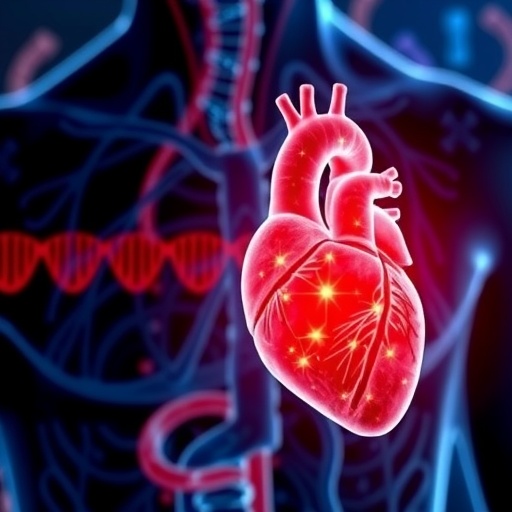In an era where cardiovascular and cerebrovascular diseases remain among the leading causes of death globally, a novel therapeutic avenue centered on microRNAs (miRNAs) is rapidly emerging as a promising strategy to tackle heart and brain infarctions associated with atherosclerosis. Recent advances have elucidated how manipulating miRNA pathways holds immense potential not only in halting disease progression but also in promoting tissue repair and functional recovery post-infarction.
Atherosclerosis, the pathological underpinning of many heart attacks and strokes, involves complex cellular interactions and gene regulatory networks modulated by miRNAs. Therapeutic approaches now leverage the nuanced roles miRNAs play in endothelial cells, macrophages, and vascular smooth muscle cells to stabilize plaques, reduce inflammation, and prevent vascular occlusion. These interventions transcend traditional pharmacology by deploying synthetic delivery systems, including nanoparticles and engineered exosomes, designed to modulate miRNA expression with high precision.
Salvianolic acid, a biologically active component derived from Salvia miltiorrhiza, exemplifies such targeted chemical therapies. It operates by upregulating let-7g expression in macrophages, leading to decreased foam cell formation—a critical step in plaque development—while simultaneously downregulating miR-338-3p in endothelial cells to protect against apoptosis. Moreover, this compound induces the transfer of miR-204-5p via endothelial cell-derived extracellular vesicles to smooth muscle cells, activating autophagy pathways that suppress cell death and foster plaque stability. Such multi-cellular regulatory effects underscore the therapeutic finesse miRNA modulation can achieve.
Parallel to chemical agents, nanotechnology innovations have revolutionized miRNA delivery and targeting. Surface modification of extracellular vesicles or nanostructures with ligands like hyaluronic acid enables selective binding to CD44 receptors on pro-inflammatory macrophages in atheromas, facilitating the enhanced delivery of miR-34c-5p and consequent reprogramming of macrophages from the pro-inflammatory M1 to the reparative M2 phenotype. This repolarization reduces local inflammation and supports vascular healing. Likewise, ultrasound-targeted microbubble disruption facilitates the selective delivery of miR-145a-5p to vascular smooth muscle cells, promoting a contractile phenotype essential for vascular integrity.
Another remarkable vector involves spherical nucleic acid nanostructures carrying miR-146a, which can autonomously enter macrophages and endothelial cells to regulate NF-κB signaling, a pivotal inflammatory cascade in atherosclerosis progression. Intriguingly, nanoparticles with the pH low insertion peptide (pHLIP) have been engineered to transport antisense oligonucleotides against miR-33 selectively into macrophages, thereby enhancing the expression of fibrogenic genes essential for plaque stabilization in advanced disease stages.
When atherosclerosis culminates in myocardial infarction, therapeutic miRNA modulation extends its utility in repairing ischemia-induced cardiac damage. Exosomes harvested from diverse cell sources such as MSCs, macrophages, and adipose tissue have emerged as dynamic delivery vehicles, transferring cardioprotective miRNAs to damaged heart tissues. For instance, miR-132-3p-enriched exosomes from M2 macrophages accelerate post-infarction angiogenesis by targeting thrombospondin-1, a known angiogenesis inhibitor, thereby fostering vascular repair.
Further refinements include the pretreatment of MSC-derived exosomes with vericiguat, which augments the expression of miR-1180-3p targeting ETS1, consequently inhibiting fibroblast proliferation and curbing maladaptive cardiac fibrosis. Precision delivery mechanisms such as ultrasound-targeted microbubble disruption of miR-125b combined with MSC membrane ligands have demonstrated efficacy in reducing cardiomyocyte death and fibroblast growth, highlighting the intersection of bioengineering and gene regulation.
Genome editing technologies have also converged with exosome biology to enable cardiac-specific modulation of detrimental miRNAs. Loading single-guide RNA ribonucleoprotein complexes against miR-34a into cardiac-targeted EVs attenuates cardiomyocyte apoptosis, offering a powerful gene-editing paradigm for myocardial injury. Additionally, exosomal delivery of miRNA combinations like miR-148a-3p can reprogram cardiac fibroblasts into functional muscle cells, offering prospects not merely to limit damage but to regenerate myocardial tissue.
Cerebral infarction, often complicated by the impermeability of the blood-brain barrier, presents additional therapeutic challenges. Nevertheless, engineered extracellular vesicles embedded with superparamagnetic iron oxide nanoparticles display remarkable capability in traversing this barrier and restoring neuronal mitochondrial function through modulation of the miR-1228-5p/TRAF6/NOX1 axis. Similarly, miR-21-5p from adipose tissue-derived stem cell exosomes induces microglial polarization toward the anti-inflammatory M2 phenotype via the PIK3R1/PI3K/AKT pathway, mitigating post-stroke neuroinflammation.
Hypoxia-conditioned MSC exosomes enriched with miR-214-3p promote cerebral angiogenesis through the PTEN/Akt signaling pathway, highlighting the adaptability of stem cell derivatives in ischemic brain repair. Innovative probes exploiting aggregation-induced emission properties have been developed to label endothelial cell-derived EVs, which ferry miR-155-5p into astrocytes and stimulate neurological recovery by downregulating the pro-inflammatory c-Fos/AP-1 signaling axis.
Neuromodulatory strategies also include pre-treating astrocytes with berberine to induce extracellular vesicle release containing miR-182-5p, which targets Rac1 to suppress neuroinflammation, thereby improving brain injury outcomes. Nanodelivery platforms like the Ca-MOF system facilitate efficient miR-124 transport, promoting neural stem cell differentiation into mature neurons vital for functional restoration post-infarction.
Circular RNA (circRNA)-modified adipose-derived stem cell exosomes offer another layer of regulation by downregulating miR-124-3p in the hippocampus and upregulating SIRT7, effectively alleviating neuronal injury and converting microglia to an anti-inflammatory state. Such multilayered regulatory circuits reveal how epigenetic and post-transcriptional modifications can be harnessed synergistically for neuroprotection.
Complementing these biological strategies, certain chemical agents and physical therapies like electroacupuncture have demonstrated neuroprotective efficacy via miRNA modulation. Electroacupuncture upregulates miR-142-5p, suppressing ADAMTS1, and consequently activating the VEGF/PI3K/AKT/eNOS pathway, which reduces infarct size. Simultaneously, it modulates miR-7 expression to derepress KLF4/VEGF and angiopoietin-2, enhancing post-stroke angiogenesis. Acupuncture also elevates miR-34c-5p to enhance cellular autophagy, a critical survival pathway during ischemic stress.
Interventions at the extracellular vesicle level extend to lithium-pretreated MSCs, whose EVs carrying miR-1906 inhibit the NF-κB pathway by targeting TLR4, lowering inflammatory responses. Transcranial focused ultrasound stimulation has been shown to elevate Nespas expression, reducing miR-383-3p and permitting expression of SHP2, a regulator that mitigates microglial pro-inflammatory cytokine production, revealing non-pharmacological approaches to influence miRNA networks.
The translational promise of miRNA therapeutics lies in their dual capacity to target upstream pro-thrombotic and inflammatory mechanisms in both myocardial and cerebral infarctions, addressing the root causes of ischemic events. By developing antagonists or mimics against key miRNAs involved in thrombosis and vascular dysfunction, it is conceivable to achieve simultaneous protection against both heart attacks and strokes.
However, post-infarction phases demand broad-spectrum neuroprotective and cardioprotective miRNA strategies that attenuate reperfusion injury, modulate oxidative stress, and promote tissue remodeling. The dissimilar microenvironment, cellular architecture, and presence of the blood-brain barrier necessitate specialized delivery systems and targeted validation in each organ to avert off-target effects.
Notably, cerebral infarction therapies confront additional pharmacokinetic challenges due to the blood-brain barrier’s selective permeability. Innovative nanocarriers, engineered EVs, and peptide-modified delivery platforms are crucial to overcoming this hurdle, ensuring therapeutic miRNAs reach neuronal targets efficiently.
As research progresses, the convergence of molecular biology, nanotechnology, and bioengineering is poised to revolutionize treatment paradigms for cardiovascular and cerebrovascular diseases. Therapeutics that harness the intricate regulatory roles of miRNAs promise a future where heart and brain infarctions are not only better managed but potentially reversed at the molecular level.
This burgeoning field holds the key to unlocking precision medicine solutions that address the multifaceted nature of ischemic diseases, coupling targeted gene regulation with advanced delivery technologies. In doing so, miRNA-based therapies stand to transform the landscape of chronic vascular diseases and their acute catastrophic sequelae.
Subject of Research: Harnessing microRNA therapeutics in the treatment of heart and brain infarctions related to atherosclerosis.
Article Title: Harnessing miRNA therapeutics: a novel approach to combat heart and brain infarctions in atherosclerosis.
Article References:
Wang, J., Li, Y., Wang, H. et al. Harnessing miRNA therapeutics: a novel approach to combat heart and brain infarctions in atherosclerosis. Cell Death Discov. 11, 482 (2025). https://doi.org/10.1038/s41420-025-02649-9
Image Credits: AI Generated
DOI: https://doi.org/10.1038/s41420-025-02649-9
Tags: cardiovascular disease treatment innovationsendothelial cell miRNA regulationextracellular vesicle miRNA transfer mechanismsgene regulatory networks in atherosclerosisinflammation reduction in heart attacksmicroRNA interventions in cerebrovascular healthmiRNA therapies for heart diseasenanoparticle-based miRNA therapiesSalvianolic acid and cardiovascular healthsynthetic delivery systems for miRNAtargeted therapies for atherosclerosistissue repair post-infarction





